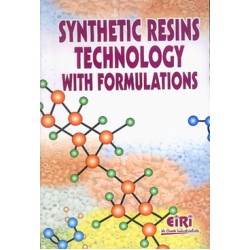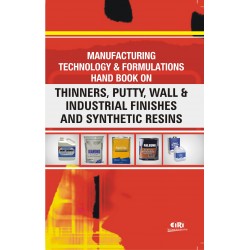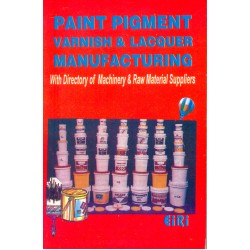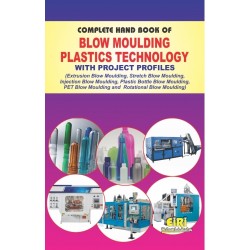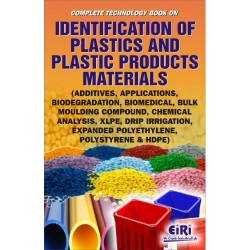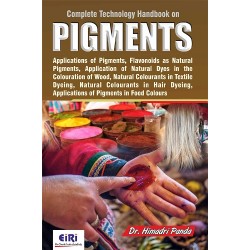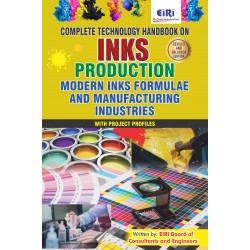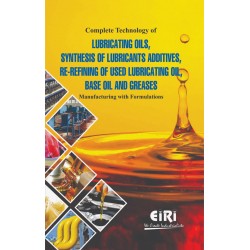technology of synthetic resins & emulsion polymers (hand book)
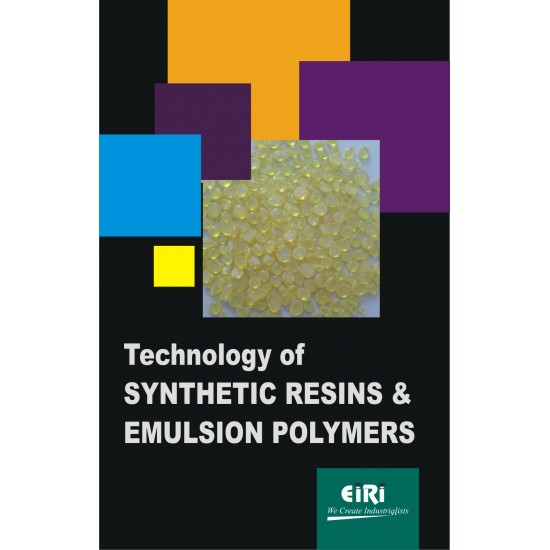
- More than 40 years of experience
- Managed by expert industrial consultants
- ISO 9001-2015 Certified
- Registered under MSME, UAM No: DL01E0012000
- 24/5 Research Support
Get your quesries resolved from an industry expert. Ask your queries before report or book purchase. - Custom Research Service
Speak to the our consultant to design an exclusive study to serve your research needs. - Quality Assurance
All reports are prepared by highly qualified consultants & verified by a panel of experts. - Information Security
Your personal & confidential information is safe & secure.
TECHNOLOGY OF SYNTHETIC RESINS & EMULSION POLYMERS
THE CHEMISTRY OF RESIN FORMATION AND RESIN PROPERTIES
Introduction
Fundamentals of Polymer formation
Functions of Reactive Groups
Cross -linked Polymers
Formation of Polymers
Polycondensation
Interfacial Polycondensation
Sequence of Reaction
Copolymer Formation
Rate of Polymerization
Addition Polymerization in Practice
Chain Transfer Reactions
Strereopsecific Polymerization
Polyaddition Reactions
Types of Polymers
Polyesters
Formation of Alkyds
Saturated and Unsaturated polyesters
Polyamides
Phenolic Resins
Amino Resins
Epoxide Resins
Vinyl Polymers
Polyvinyl Alcohol
Silicones
Practical Applications
THE CHEMICAL ENGINEERING OF OIL AND RESIN PROCESSING
General Requirements for Processing Equipments
Materials of Construction
Branches and Connections
Stirring Equipment
Types of Agitators
Sealling
Drive Units
Fume Disposal and Scrubbing
Desing Consideration
Sludge Handling Equipment
Condensing and Refluxing
Design and Layout of Tubes
Water Receiver
Ancillary Equipment
Agitators
Heating
Reflux Condenser
Thermometer
Steam Arrangements
Vacuum Pumps
Pressure and Flow Indication
Fume Extraction
Lagging
Miscellaneous
Heating and Cooling
Criteria for Selection of Heating and Cooling system
Calculation of Film Coefficients
Heat Transfer Coefficient
Steam Heating
Pressurised Hot Water
Heating at Higher Temperature
Direct Firing
Immersion Tubes
Kestner Coil
Typical Arrangement
Cooling
The advantages of this type of heating system are
Heating by Electricity
Immersion Heating
Heating through The Vessel Wall
Induction Heating
Isoductive Heating System
Heating of Pipework and Ancillaries
ALKYD RESINS
The nature of Alkyd Resin
Raw Materials
Dibasic Acids
Polyhydric Alcohols
Modifier for Alkyd Resins
Formulation of Alkyd Resins
Formula Development
Calculation of Alkyd Formulations
Typical Formulations
Manufacture of Alkyd Resin
Alcoholysis
Catalysts
Control of Alcoholysis
Acidolysis
Fatty Acid Process
Esterification
Alkyd Manufacturing Plant
Applications of Alkyd Resins
Oil Froe Alkyds
POLYESTER
Saturated Polyesters
Condensation and Addition Polymerization
Main Components of Unsaturated Polyesters
Brief History of Surface Coatings
Characteristics of Unsaturated Polyesters
Two points should be noted here
Functions of Initiators Accelerators, Inhibitors
Effect of structure of Polyester Backbone on Properties of Cured products
Effect of Chemical structure on Melting points of Linear Polyesters
Effect of Structure on Properties of Cured Products
Commonly used polyols and their advantages are
The effect of unsaturated monomers on properties of cured products
Polyester coating composition
Radiation Cure
Methods of Application
AMINO RESINS
Formation of Amino Resins
Methylol formation
Alkylation
Urea Formaldehyde Resins
Methylol Formation
Etherification reaction
Melamine Formaldehyde Resin
Melamine Methyl Formation
Alkylation of Melamine Methylots
Other Amino Resins
Glycoluril
Production Amino Resins
Properties of Amino Resins
Uses of Amino Resins
Self Polymerization
Co reaction with alkyd and polyester resins
Co-reaction with Acrylic Resins
Epoxy resins
Acid Catalysed Lacquers
Water based Coatings
Appendix 1 Solvent Tolerance
Appendix 2 NonVolatile Content
POLYURETHANE RESINS
Chemistry
Raw Materials
Isocyanates
Toylene Diisocyanate (TDI)
4,4' Diphenylmethane Diisocyanate (MDI)
Hydroxyl Component
Hazards of Isocyanates Classification of Polyurethanes
Urethane Oils and Urethane Alkyds
Moisture cured urethanes
Blocked Isocynatiee Systems
Two component catalyst cured Polyurethanes
Two component Polyol Type Polyuethanes
EPOXY RESINS
Epoxy Resins Manufacture and Characterization
Curing Agents for Epoxy Resins
Principles n Formulating with Epoxy Resins
Solventless and High Solids Coatings
Tar Epoxy Coatings
Flooring Compounds
Fibreglass Laminates
Solvent based Paint
High Solids Coatings
Solventless Tar Epoxy Coatings
Solventless Coating for Airless Spray Equipment
Single Pack Epoxy Maintenance Paints
Epoxy Esters
Single Pack Thermoplastic Epoxy Systems
Epoxy Industrial Baking Finishes
WATER DISPERSIBLE EPOXY RESINS
Epoxy/Polyamide Emulsions
Epoxy Baking Enamels
Water Dispersible Epoxy
Resin Coatings for Electrodeposition
Epoxy Aqueous Powder Suspension (APS)
SILICONE RESINS
Direct Process
Grignard Process
Preparation of Silanots
Polymerization
Silicone resins
Pure Silicone Resins
R:Si Ratio
Methyl and phenyl content
Viscosity
Properties of pure Silicone
Surface Coating Resins
Resistance to Weathering
Bending Resins
Silicone Intermediates
Silicone Organic Copolymers
Preparation and Formulation of Silicone Resin Based Coatings
Cure Catalyst Driers
Pigments and Dyes
Thinners
Application Guides
Surface Preparation
Priming
Applying the Coatings
Curing
Uses
Toxicity
Other Silicone Resin
Application
Electrical Varishes
Release Resins
Masonry Water Repellants
other Silicones for Surface Coatings
ACRYLIC SOLUTION RESINS
Backbone Monomers
Synthesis
Addition Polymerization
Copolymerization
Thermoplastic Acrylic
Solution Polymerization
Properties and End Uses
Thermosetting Acrylics
Selection of Monomer
Classification and properties
Acrylamide Copolymers
Acid Copolymers
Hydroxy Copolymers
Curing Reactions
Aqueous Solution Acrylics
Non Aqueous
Dispersions (NAD)
RUBBER RESINS
Introduction
Natural Rubber
Synthetic Rubbers
Procedure
Rubber Resins and Latexes
Chlorinated Rubber Resins
Lifting
Parlon
Cyclized Rubber Resins
High Styrene Butadiene
Rubber Resins
Chrolorinated Biphenyls
Chlorinated Paraffins
Synthetic Rubber Resins Latexes
EMULSION POLYMERS
Key Components in Emulsion Polymerization
Surfactants
Initiators
Water
Polymerization in Emulsion Systems
Based on Styrene
Influence of Monomer Componsition of roperties and performance
Hardening Monomers
Vinyl Acetate
Styrene
Methyl Methacrylate
Flexibilizing Monomers
Esters of Acrylic Acids
Esters of Maleic or Fumaric Acids
Vinyl Esters
Olefins-Butadiene
Olefins-Ethylene
Specific Monomers
Effect of Monomer Composition on Film Properties
Effect of Water Phase and Particle Size
Particle Size
Manufacture and Testing
Process Variables
Emulsion Testing
Application of Emulsion Polymers
Adhesive Industry
The Printing Ink Industry
The Printing Ink Industry
The Textile Industry
The Leather Industry
The Floor Polish Industry
The Paper Industry
The Agriculture Industry
Soluble Alkyds
Disadvantages are
Polyesters
Silicone modified Alkyds and Polyesters
Epoxy Resins
Anhydrides
Defunctioalizing the Epoxide Ring
Cationic Polymers
Thermoplastic Polymers
Thermosetting Polymers
Amino Resins
Urea Formaldehyde
Melamine Formaldehydes
Substituted Guanamine Formaldehyde
Self cross linking
Other Water soluble Polymers
Viscosity Characteristics
Amines
Viscosity
Drying
Stability
Foam Control
Colour Retention
Toxicity
Variation of Amine Levels
Viscosity
Drying Properties
Stabilit
Gloss
Cosolvents
Coupling Efficiency
Viscosity
Variation of Cosolvent water ratio
Stability
Drying properties
Foam Control
Drier for air dry and Force dry systems
Cross Linking os water Soluble coatings
Additives for Coatings
Pigments
Formulation of Water Soluble Coatings
Trouble Shooting with Water Soluble Polymers
WATER SOLUBLE POLYMERS
Classification
Properties of Cellulose Ethers
Application
Uses
Engineers India Research Institute (EIRI) is a renowned name in the industrial world for offering technical and financial
consultancy services.
EIRI services are:
Detailed Feasibility Reports
New Project Identification
Project Feasibility and Market Study
Identification of Lucrative Industrial Project Opportunities
Preparation of Project Profiles / Pre-Investment and Detailed Feasibility Studies,
Market Surveys / Studies, Market Survey Cum Detailed Techno-Economic Feasibility Reports
Project Reports in CD Roms
Identification of Plant /Process/Machinery and Equipment, Industrial General Guidance for setting up new industrial
projects.
Our most up-to-date and Technologically Advanced Industrial Project Reports, categorized with respect to Financial
Outlays and Sector – wise Classification are immensely useful for :
Existing Small or Medium Scale Industrialists facing competition from large houses
Young Entrepreneurs dreaming to start their own industrial enterprise
Young Graduates and Professionals wishing to begin their career
Industrialists interested in Debottlenecking their capacities & New Product – Lines
Large Industrial Houses pursuing Expansion, Growth and Diversification Plans
How to Make Project Report?
Detailed Project Report (DPR) includes Present Market Position and Expected Future Demand, Technology, Manufacturing Process, Investment Opportunity, Plant Economics and Project Financials. comprehensive analysis from industry covering detailed reporting and evaluates the position of the industry by providing insights to the SWOT analysis of the industry.
Each report include Plant Capacity, requirement of Land & Building, Plant & Machinery, Flow Sheet Diagram, Raw Materials detail with suppliers list, Total Capital Investment along with detailed calculation on Rate of Return, Break-Even Analysis and Profitability Analysis. The report also provides a birds eye view of the global industry with details on projected market size and then progresses to evaluate the industry in detail.
We can prepare detailed project report on any industry as per your requirement.
We can also modify the project capacity and project cost as per your requirement. If you are planning to start a business, contact us today.
Detailed Project Report (DPR) gives you access to decisive data such as:
- Market growth drivers
- Factors limiting market growth
- Current market trends
- Market structure
- Key highlights
Overview of key market forces propelling and restraining market growth:
- Up-to-date analyses of market trends and technological improvements
- Pin-point analyses of market competition dynamics to offer you a competitive edge major competitors
- An array of graphics, BEP analysis of major industry segments
- Detailed analyses of industry trends
- A well-defined technological growth with an impact-analysis
- A clear understanding of the competitive landscape and key product segments
Need Customized Project Report?
- Ask for FREE project related details with our consultant/industry expert.
- Share your specific research requirements for customized project report.
- Request for due diligence and consumer centric studies.
- Still haven't found what you're looking for? Speak to our Custom Research Team
About Engineers India Research Institute:
Note: We can also prepare project report on any subject based on your requirement and country. If you need, we can modify the project capacity and project cost based on your requirement.
Our Clients

Our Approach
- Our research reports comprehensively cover Indian markets (can be modified as per your country), present investigation, standpoint and gauge for a time of five years*.
- The market conjectures are produced on the premise of optional research and are cross-accepted through associations with the business players
- We use dependable wellsprings of data and databases. What's more, data from such sources is handled by us and incorporated into the report
Why buy EIRI reports?
- Our project reports include detailed analysis that help to get industry Present Market Position and Expected Future Demand.
- Offer real analysis driving variables for the business and most recent business sector patterns in the business
- This report comprehends the present status of the business by clarifying a complete SWOT examination and investigation of the interest supply circumstance
- Report gives investigation and top to bottom money related correlation of real players/competitors
- The report gives gauges of key parameters which foresees the business execution





















